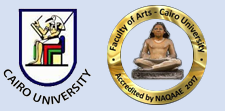عنوان المقال عربي
التذوقُ الفنيُّ لفن المُنَمْنَمَات من خلال الوصف الأدبي للمُكون التشكيلي: رواية (اسمي أحمر) أنموذجًا
Document Type
Original Study
Subject Area
Language and Literature
Keywords English
My name is red, miniatures, Islamic art, fiction literature, parallel texts.
كلمات مفتاحية عربي
· اسمي أحمر، المُنَمْنَمَات، الفن الإسلامي، الأدب الروائي، النصوص الموازية.
Abstract English
The novel (My Name Is Red) is a unique literary product in dealing with plastic art in general, and the art of Islamic miniatures in particular, presented by the Turkish novelist Orhan Pamuk, a novel translated into Arabic in 2000 by Abdulkader abdulli. The importance of this work goes beyond for those engaged in plastic art in general to reading the textual thresholds and their significance in the literary work, as this novel points to a central point of discussion for art, which is the Prohibition of the representation of spirits in Islamic art, and the scale of the conflict between religious schools and Ottoman art on this issue. That what the novel presented seems radically different, both in terms of the textual thresholds in its title, which is combined with the red color as the most used in Islamic painting from one angle, or in terms of quantity and type, as the writer went beyond the usual traditional description of art forms, to employ rhetorical diagnosis, which gave the novel another dimension, when he made those miniatures pronounce and narrate themselves from another angle. This study examines the strength of the novelist in his literary work from the point of view of his artistic taste, a novelist who never belonged to the field of plastic art, and the extent of the author's success in absorbing the plastic components of the arts of Islamic miniatures.
الملخص العربي
تُعدُّ رواية (اسمي أحمر) نتاجًا أدبيًا فريدًا في تناول الفن التشكيلي عامة، وفن المُنَمْنَمَات الإسلامية خاصة، لكونه موضوعًا أصيلًا تدور حوله أحداث الرواية، التي قدّمها الروائي التركي أورهان باموق، الحائز على جائزة نوبل للآداب عام 2006 عن روايته (اسمي أحمر)، وهي الرواية التي نُشرت لأول مرة باللغة التركية عام 1998م، ثم ترجمها إلى العربية عام 2000 عبد القادر عبد اللي وتكمن أهمية هذا العمل في كونها تتجاوز بالنسبة للمشتغلين بالفن التشكيلي عمومًا قراءة العتبات النصية ودلالتها في العمل الأدبي، إذ تُشي هذه الرواية إلى نقطة نقاش مركزية بالنسبة للفن، وهي تحريم تمثيل ذوات الأرواح في الفن الإسلامي، وحجم الصراع بين المدراس الدينية والفنية العثمانية في الحقبة التاريخية التي سبرتها الرواية. إن ما قدمته الرواية يبدو مختلفًا جذريا، سواء من حيث العتبات النصية في عنوانها المتلازم باللون الأحمر بوصفه الأكثر استخدامًا في الرسم الإسلامي، أم من حيث الكم والنوع، إذ تجاوز الكاتب الوصف الاعتيادي التقليدي للأشكال الفنية، إلى توظيف التشخيص البلاغي، الذي أكسب الرواية بُعدًا آخر، حين جعل تلك المُنَمْنَمَات تنطق وتسرد بذاتها. ومن ثّمَّ؛ تأتي هذه الدراسة لتبحث قوة الروائي في عمله الأدبي من زاوية تذوقه الفني، وهو الروائي الذي لم ينتمِ يومًا إلى حقل الفن التشكيلي إلا لكونه متذوقًا، ومدى نجاح المؤلف في استيعاب المكونات التشكيلية لفنون المُنَمْنَمَات الإسلامية.
Recommended Citation
Al-Maamari, Badr and Al-Ghasini, Zaher
(2024)
"Artistic taste of the art of miniatures through the literary description of the plastic component: The novel (My Name Is Red) as Case Study,"
Journal of the Faculty of Arts (JFA): Vol. 84:
Iss.
4, Article 4.
DOI: https://doi.org/10.70216/2682-485X.1659
Digital Object Identifier (DOI)
10.70216/2682-485X.1659
Publication Date
10-4-2024


